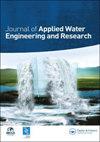有机氯农药在河流中的扩散-平流过程模拟
IF 1.6
Q4 WATER RESOURCES
Journal of Applied Water Engineering and Research
Pub Date : 2021-10-03
DOI:10.1080/23249676.2021.1982029
引用次数: 7
摘要
本文研究了局部河流中有机氯农药的扩散-平流过程模型。新颖之处在于提出了计算OCPs平流-扩散过程与OCPs生化转化过程相结合的物理系数(分子扩散、平流扩散、分配)和生化系数(底物利用率)的数学表达式。所涉及的ocp是ddt (p.p ' -DDT, o.p ' -DDT, p.p ' -DDD, p.p ' -DDE, o.p ' -DDE)和DRINs (Aldrin, Dieldrin和Endrin)。校准了四种情景来模拟OCPs的传输:(1)分子扩散,(2)生化转化,(3)平流-扩散和(4)平流-扩散、生化转化和吸附/脱附的组合过程。评估情景对ocp的时空分布有较好的预测能力,预测能力在观测值与模拟值之差均值1.5标准差范围内。与耦合模式相关的情景N°4对热带河流过程提供了较好的预测。本文章由计算机程序翻译,如有差异,请以英文原文为准。
Diffusion–advection process modeling of organochlorine pesticides in rivers
This paper deals with the diffusion–advection process modeling of organochlorine pesticides (OCPs) dissolved in a topical river. The novelty consists of proposing mathematical expressions to estimate the physical coefficients (molecular diffusion, advective diffusion, partition) and biochemical coefficients (substrate utilization rate) of OCPs advection–diffusion processes combined to OCPs biochemical transformation processes. The OCPs involved were DDTs (p.p’-DDT, o.p’-DDT, p.p’-DDD, p.p’-DDE, o.p’-DDE) and DRINs (Aldrin, Dieldrin and Endrin). Four scenarios for simulating the OCPs transport were calibrated: (1) molecular diffusion, (2) biochemical transformation, (3) advection–diffusion and (4) a combination of advection–diffusion, biochemical transformation and sorption/desorption processes. The evaluated scenarios predicted with a good approach to the OCPs’s spatio-temporal distribution with a prediction capability within an interval until 1.5 standard deviation with respect to the mean of difference between observed and simulated OCPs The scenario N°4 associated to a coupled model offered a suitable prediction of processes for a tropical river.
求助全文
通过发布文献求助,成功后即可免费获取论文全文。
去求助
来源期刊

Journal of Applied Water Engineering and Research
WATER RESOURCES-
CiteScore
2.90
自引率
16.70%
发文量
31
期刊介绍:
JAWER’s paradigm-changing (online only) articles provide directly applicable solutions to water engineering problems within the whole hydrosphere (rivers, lakes groundwater, estuaries, coastal and marine waters) covering areas such as: integrated water resources management and catchment hydraulics hydraulic machinery and structures hydraulics applied to water supply, treatment and drainage systems (including outfalls) water quality, security and governance in an engineering context environmental monitoring maritime hydraulics ecohydraulics flood risk modelling and management water related hazards desalination and re-use.
 求助内容:
求助内容: 应助结果提醒方式:
应助结果提醒方式:


